My driver “Cesar” arrived slightly early in Uyuni to drive me to Sucre, approximately 300 km away. The drive was going to take the better part of the day as much of the trip was through the Andes on a very windey road. Now the bad news. Cesar did not speak English and my Spanish is pretty limited although after almost a month in South America, I have found that my comprehension is much improved and I know enough basic words and phrases to get by. However, 7 hours in a car was going to be challenging.

Cesar turned put to be a very good and careful driver (and in Bolivia that is saying a lot). The majority of the trip was in silence, but periodically, Cesar would point out a landmark or mountain, and I was able to understand what he was tying to tell me.

Now the trip proved to be very, very picturesque. We began the trip by climbing higher into the Andes where I once again encountered snow and lots of llamas and vincunas. Unfortunately, I did see the first dead llama on the side of the road, right near a llama crossing sign. Oh the irony.


We wound up and down and round and back again through the Andes, but about an hour and a half into the trip, we left the snow behind and began to see cactus all over the hillsides. Cesar insisted we stop so I could take a picture.
By noon we had hit the silver mining town of Potosi (Cesar’s home). Cesar asked me in Spanish if I was hungry. After fumbling with my Spanish words, I finally managed to convey that I was a little bit hungry and would like to stop for some soup. After a quick lunch and a short detour through Potosi so Cesar could show me the town square and the parliament buildings, we were back on the road.



Now while we were still high in the Andes (around 9,000 feet), the ground had leveled off and we began to pass farms with a lot of cattle and pigs. In fact, once past Potosi, we did not see another llama or vincuna. The little farms eventually gave way to massive canyons, gorges and rivers and before you knew it, we were heading into the outskirts of Sucre aka the White City.
Now Sucre is the constitutionally declared capital of Bolivia, but the legislative and judicial branches of the government were moved to La Paz, so Sucre is simply the symbolic capital. Sucre, is however, the city where Simon Bolivar and General Sucre liberated the country from the Spanish in 1825. The city is said to be the prettiest city in Bolivia (and from I have seen, I can’t argue that). Everywhere you look, you see white stucco, adobe walls, terracotta tiles, flowers, trees and cobble stone streets. And because the government strictly controls building, the gorgeous colonial buildings and architecture have been preserved resulting in Sucre being declared a UNESCO World Heritage site in 1991.

I was settled into my beautiful colonial hotel in short order and then found a map and began to wander the narrow little streets. Everything in Sucre is so compact, it is very easy to get around. First up was finding a place to eat. By now the sun was down and the residents and street vendors were out in force. I ended up settling on a little bar called the Joy Ride Café. It turned out to be a homerun. Not only were the tapas I ordered delicious (and as usual in Bolivia way, way, way too much), but the bar included a little slice of Seattle … someone had bequeathed a 12th Man Flag that was hanging in the bar above the Real Madrid scarf. I did a double take when I saw it. Of course I took a picture.
I got to bed pretty early and slept in a nice warm room for the first time in 4 nights. And the best part, an incredible supply of hot water. I think I stood in the shower for ten minutes not moving. It was a welcome return to humanity after 4 days of luke warm to out right cold showers.
Anyway, I was up early for a walking tour I had signed up for that began at 10:00 a.m. I found the Condor Café and Trekking company a few short blocks from my hotel, and because I was early I ended up ordering some hot chocolate. Chocolate is a specialty in Sucre and this hot chocolate may have been the best tasting I have ever had. Rich, creamy and a glorious velvety chocolate taste. Yummy.

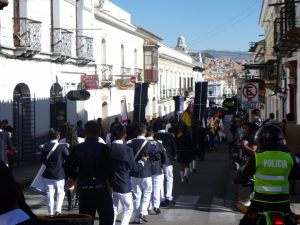
As I was sitting there, I saw a crowd gathering outside and sure enough, it was another Bolvian parade. This time it was a parade to celebrate the anniversary of a local school. All the little ones were lined up marching with the older kids playing musical instruments behind the kids. It was incredibly cute and a lovely way to start the morning.
Once 10:00 a.m. hit, “Tito” our guide assembled the little group: a couple from Ireland, a woman from France, a guy from the Netherlands and a guy from Utah. (Everyone in the group turned out to be super nice, hard core travellers so we had great fun exchanging stories about where we had travelled to date.)
We set off across the street for a little Indigenous store and were accompanied by two dogs who apparently follow the morning tour group each day. Anyway, once at the store, Tito provided us with a history of the local indigenous peoples, the Jalq’a and Tarabunco. We learned about each group’s weaving techniques and their current style of dress and culture. It was a lovely and highly unusual way to begin a city walking tour.
Next up was a stop at Chocolates Para Ti where we were able to sample two chocolates of our choosing. I selected the orange chocolate and the lemon white truffle. Absolutely wonderful. (In fact, I went back later and purchased a large bar of chocolate and plan to return to take the tour of the chocolate museum – beats the hell out of any other museum you could think of in my opinion.)


We then moved on to Plaza 25 de Mayo where we took in the Cathedral, the regional and city government offices and the Casa de la Libertad, which houses the a museum detailing the history of the Bolivian fight for independence (I plan to visit there tomorrow). The plaza is incredibly popular and was filled with tourists, locals, and school kids (including those from the parade). In the middle of the Plaze is a large statute of General Sucre flanked by a lion. The plaza was filled with the beautiful aroma of flowers and large trees everywhere. Clearly this was a place to hang out and enjoy life.
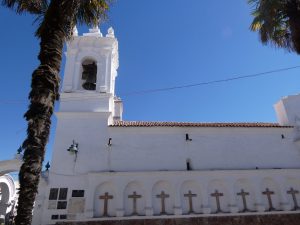

We left the plaza and walked across the street past the San Francisco Church and the Plaza Juan Frias de Herran before crossing the street to the Mercado Central. Now I love a good market and this one had everything. However, the best part was the we were able to sample some very unusual fruits. The first was a chirimoya. The exterior reminded me a bit of dragon fruit, but this fruit had a very creamy white flesh and was incredibly sweet. Second was a cross between a mango and a papaya, which was simply delicious. The final sample was a small banana. It was good, but nothing close to the first two.


Once the sampling was complete, we wandered through the herb market, the spice market, the flower market and then down the steps past the meats and cheeses to the street. We walked three blocks up the street (close to my hotel) to the Prefectura de Chuquisaca (which now houses part of St. Xavier College of Law). The building was absolutely gorgeous and in the afternoon after school is out, you can climb to the top of the building to see the view of the city. Ironically my room looks directly to the top of the building so I figure my view is just as nice as that you find at the college so no stair climb for me.


After a brief rest at the college, we then crossed the street and walked a few blocks to Plaza de LIbertade where we saw another monument to the revolution before walking past the monument and down the block past Hospital Santa Barbara (the oldest hospital in Sucre) to the Supreme Court building, a magnificent white building designed in colonial Spanish architecture.
Now as we walked and took in each of the sites, Tito gave us a running commentary on the history of Bolivia and the significance fo the sites we were seeing. Tito was highly entertaining and at the same time full of really interesting information.


Anyway, across the street from the Supreme Court building was the Parque Bolivar, a massive public park donated to the city by a wealthy couple. The park is absolutely beautiful with a variety of trees, flowers and park benches for relaxing. We took a walk through the park and at the southern entrance we saw the dancing fountains. Unfortunately, the shows are only on Saturdays so I would have to come back if I wanted to see the one and half hour show.
After the walk through the park, we hopped onto one of the local buses and road it around the city and up the hill to the Ricoleta district, which is the oldest district in Sucre. (Unfortunately, we left our little buddies behind as they were not allowed on the buses.)


One in Ricoleta, we walked past beautiful colonial buildings that lined three streets known as Gato Blanco (white cat), Gato Negro (black cat) and Gato Pardo (brown cat). And thankfully we took the bus because the walk to the Ricoletta district is straight up hill.
We made our first stop in the area at a Chicha bar, where we all took a small shell filled with Chicha (a corn based liquor popular in Peru and Bolivia) and sucked it back (it was after all past noon). The locals in the bar looked pretty amused at the faces we all made when we drank the rather pungent brew.


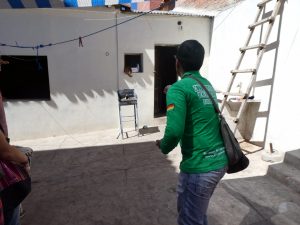
Before we left, we played sapo or the frog game as I call it. I had played this once before in Peru in 2010 and it is great fun. You have 12 coins and the goal is to get the coin into the frog’s mouth. The frog is surrounded by holes and you receive varying points depending upon which hole the coin falls into. The game is very much like quarters.
After we all took turns at sapo (and failed miserably), we left the bar and walked up the street to the Plaza de Anzure, which was bounded on one side by the 17th century La Recoleta Monastery, an amazing looking church that doubles as a museum, and on the other by a long corridor of arches that provides the best view of Sucre in the city.
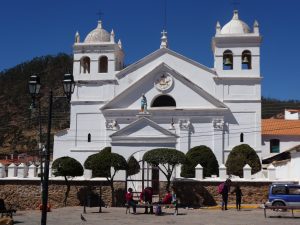


We stood for a bit and admired the view and were able to pick out all of the places we had visited on our three hour tour. We then hiked back down the hills to the Condor Café, where our day began 3 plus hours earlier. It had been a marvelous tour of a beautiful city. I was, however, exhausted. The city was actually quite warm and I was in need of a little siesta.
Once back at my hotel, I took a rest then found a lovely restaurant recommended by Tito where I once again ate Mondongo (and again failed to finish half of it). I then wandered back to my hotel and spent the remainder of the afternoon on one of the terraces simply doing nothing. What a great day!
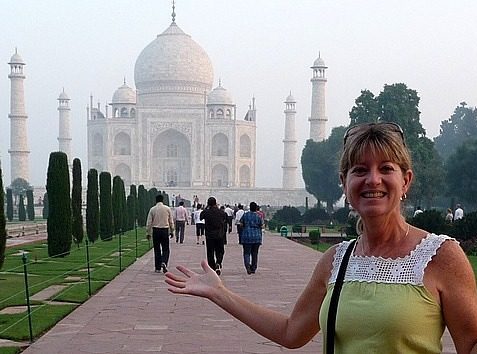
No Carmel? Hahaha
Dulce de lece